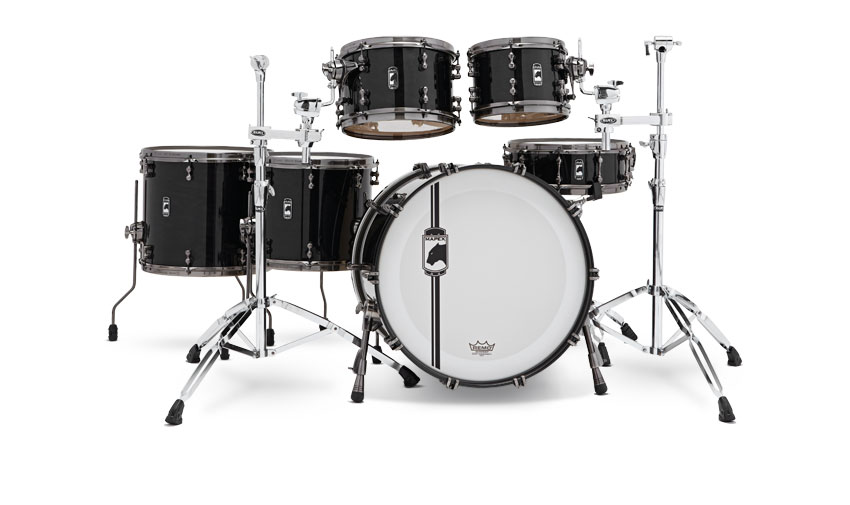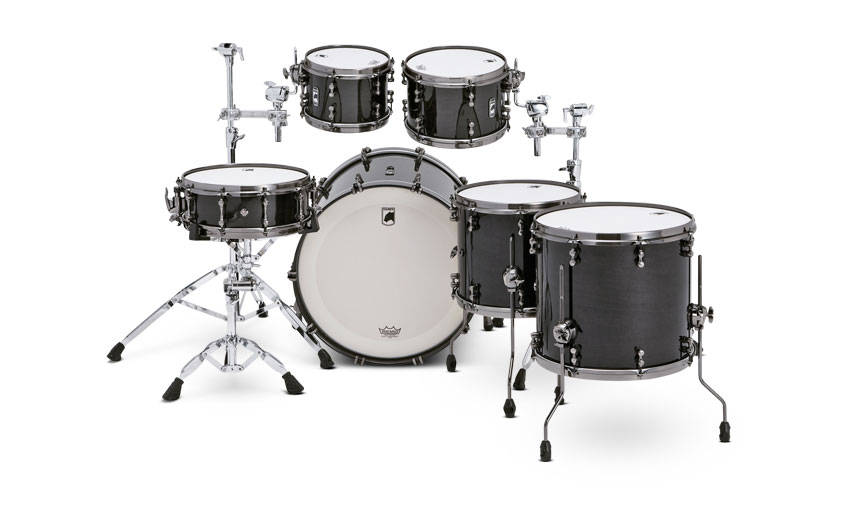MusicRadar Verdict
Drums have to be special to join Mapex's Black Panther range and the Black Widow kit definitely fulfils the entry requirements.
Pros
- +
Great built quality and detailing. Warm, resonant toms. Flexible snare.
Cons
- -
The lack of options and limited production run is an interesting tactic that risks being self defeating, but if anything it makes the kit even more desirable.
MusicRadar's got your back

Mapex Black Panther Widow Kit

Rear
Mapex's Black Panther series was relaunched in 2010 as a collection of 14 high-spec snare drums built from many different, often exotic, shell materials. Since then, three entire Black Panther kits based on individual snares have been produced in limited numbers. Following in the footsteps of the well-received Blaster, Velvetone and Retrosonic kits comes the Black Widow.
Build
The production run is again limited for the Mapex Black Panther Black Widow kit, with a mere 30 sets projected to reach the UK. While a finite number of each of the Black Panther kits has been built, the snares that inspired them remain in production. Reflecting this, the kits are sold as bass drum, tom and floor tom shellpacks while the snares are available separately.
As with the three Black Panther kits that preceded it, the Black Widow kit is available in only one configuration - in this case 22"x18" bass drum, 10"x7" and 12"x8" toms and 14"x12" and 16"x14" floor toms - and in one finish, Transparent Black Lacquer. The snare also comes in a single size - 14"x5" - and the same black finish.
In comparison with the maple/walnut Blaster, maple/walnut/maple Velvetone and the all-walnut Retrosonic, the Black Widow shells are a relatively conventional all-maple build. Across the kit the shells are straight-sided (ie: no reinforcement rings), 6-ply and 100 percent North American maple.
"The standard of construction is excellent, with the individual shells being well within tolerance for roundness and beautifully finished in general"
The snare, toms and floor toms are 5.1mm thick while the bass drum's chunkier individual plies means it comes in at a stouter 7.2mm. The standard of construction is excellent, with the individual shells being well within tolerance for roundness and beautifully finished in general. Bearing edges are cut with rounded rather than sharp peaks in order to maximise head contact and promote a full-bodied response.
Again these are bang on the mark for accuracy and consistency. While the insides of the shells are sanded to a fine smoothness, on the outside the theme is most definitely black. To Mapex's credit there are no half measures with execution of the finish, and the Transparent Black Lacquer is deep and glossy while still allowing the grain of the wood to show through from below.
Meanwhile every single piece of shell hardware down to the tension rods is nickel-plated. This commitment to visual noir is followed through to the point of obsession, with even the nylon washers being black. On the snare drum the cord that attaches the wires to the snare release and butt end is, inevitably, also black.
Black Panther double-ended tube lugs that taper sinuously in the middle are fitted to the snare drum. The rest of the drums sport individual short tube lugs, seen previously on the one-off Black Panther Sledgehammer kit and not slated to feature on any other Mapex drums.
Thick rubber washers in (you've guessed it) black insulate the shell at the twin points of contact. Mapex's SONIClear tom mounts hook onto the narrow mid-section of two lugs on each rack tom. A third stabilising arm on the mount that points downwards is simply fitted with a rubber stop to protect the shell.
The mounts appear to be permanently attached and don't impede head changing. Sonic Saver hoops, with their curved top lip, are found on the snare, toms and floor toms. An exclusive Black Panther component, they are an ingenious compromise between tripled-flanged and die-cast hoops. Matching maple hoops top and tail the bass drum.
Hands On
Ambassador thickness Remo Suede heads are fitted to the toms and floor toms while the bass drum is shod with a pair of Suede Powerstroke 3s. The Suede heads bring more than a touch of warmth with them, emphasising the toms' sweetness over pure power.
That's not to say that they don't ignite when dug into as they will sing as loud as you're prepared to hit them. However, the notes are so rich and full - even when tapped enquiringly - that I find myself actually underplaying. Sparse, Ringo-style tom orchestrations become the order of the day, allowing each tom's smooth decay to overlap the next until all four are meshing in harmony.
"At one point we let our guard drop and begin a Phil Collins trademark peal around the kit... and once you've started it's impossible to stop"
At one point we let our guard drop and begin a Phil Collins trademark peal around the kit... and once you've started it's impossible to stop, much to the amusement and bemusement of the rest of the band.
Swapping Suede Ambassadors for clear versions brings a darker, even more saturated tonality to the toms. This writer prefers the original Suede heads for their wide open sound, yet still with some semblance of control. The same qualities are present in the undrilled bass drum, which produces a deep, expansive and breathy note. Like the toms it responds with all its frequencies when played softly and any overtones that are generated are so harmonious they are welcome guests.
Similarly, as the playing velocity increases, its response seems to expand to fill all available space. The warmth discernible at the edge of the note doesn't mask the thunderous power on tap when sufficient force is engaged. Burying the beater clips some of the decay and with it warmth, making for a harder, more focussed sound. Letting the beater fall away encourages a Bonham-esque rumble of low end with each stroke.
Cutting a port in the front head (at the request of the sound engineer) reduces the level of resonance minimally, but dampening is not required at any point. Although fitted with a regular Ambassador batter rather than a Suede head the snare still possesses a good deal of the finesse and depth found in the toms and bass drum. Crisp and assertive attack is augmented by a woody note that drives the sound through.
At 5" deep a quick response is virtually guaranteed and the snare doesn't disappoint here, out of the blocks on the 'b' of each beat. We found it surprisingly good at dealing with the extremes of tuning, gigging it first with a ska band and then with a pub rock covers band.
For the ska gig we cranked the batter head up so far it felt more like a table top than a drum, but the snare still sang without choking and was sensitive across the head. Tuned at a gentler mid tension for the pub covers band, the snare coped equally well, delivering an appropriately throaty note with no little power.
“Even my cat is disappointed in me”: Deadmau5 gets drunk at Coachella, falls over, is escorted off stage by security, and apologises
“The last thing Billy and I wanted to do was retread and say, ‘Hey, let’s do another Rebel Yell.’ We’ve already done that”: Guitar hero Steve Stevens lifts the lid on the new Billy Idol album
"This $399 item will incur over $578 in additional import charges": Price of Sonicware CyDrums drum machine more than doubles thanks to Trump tariffs









